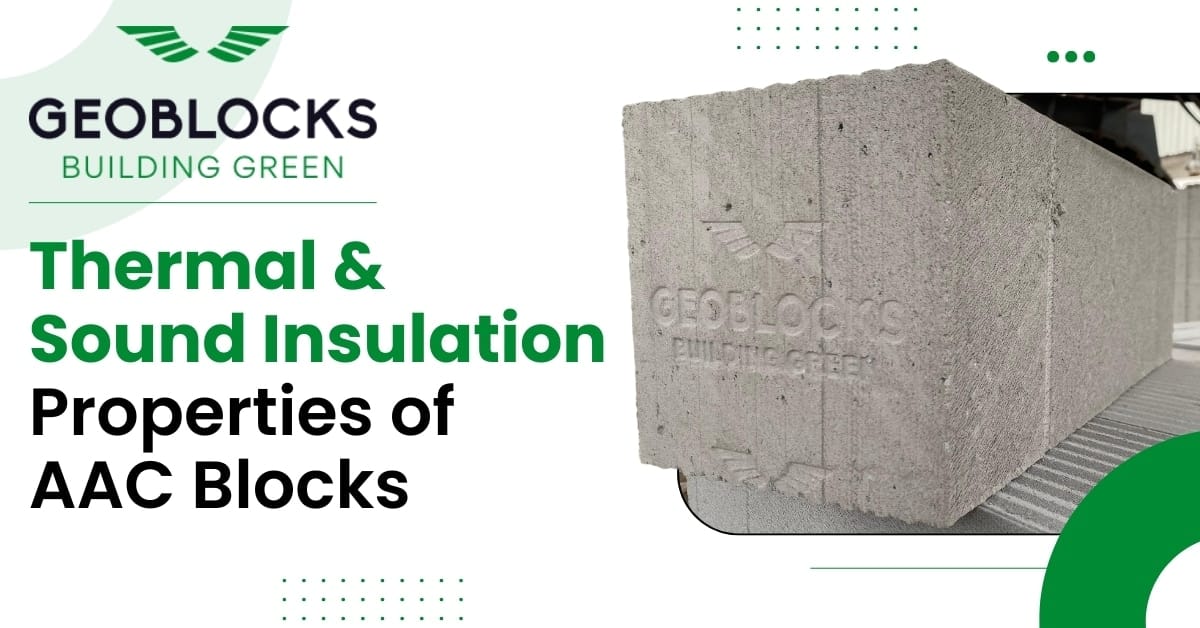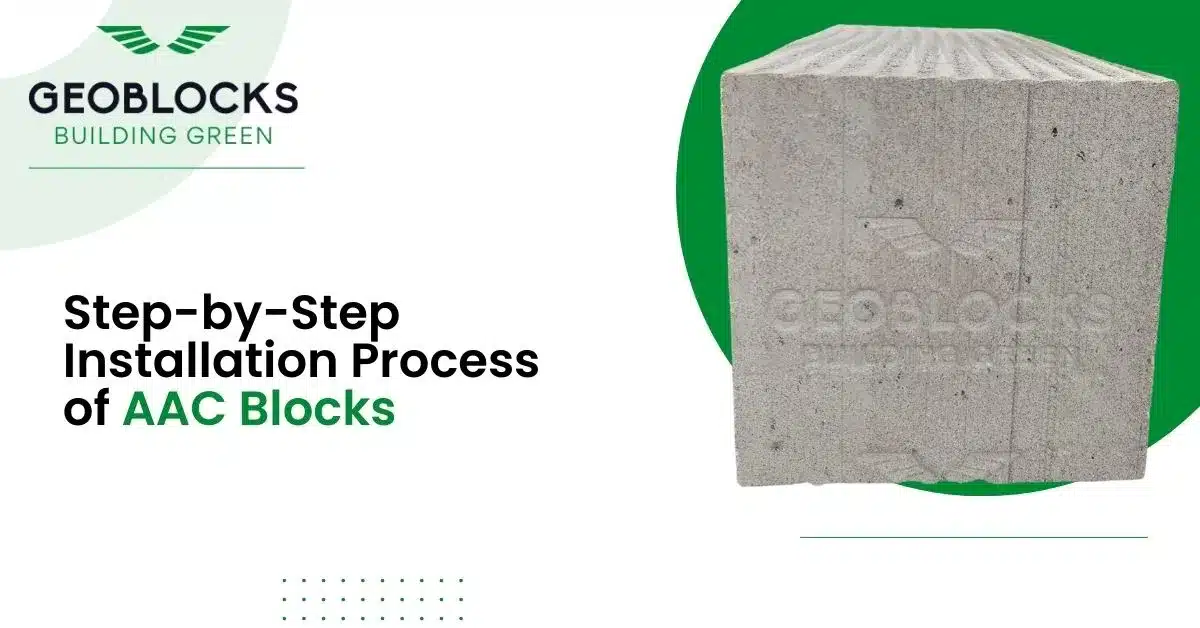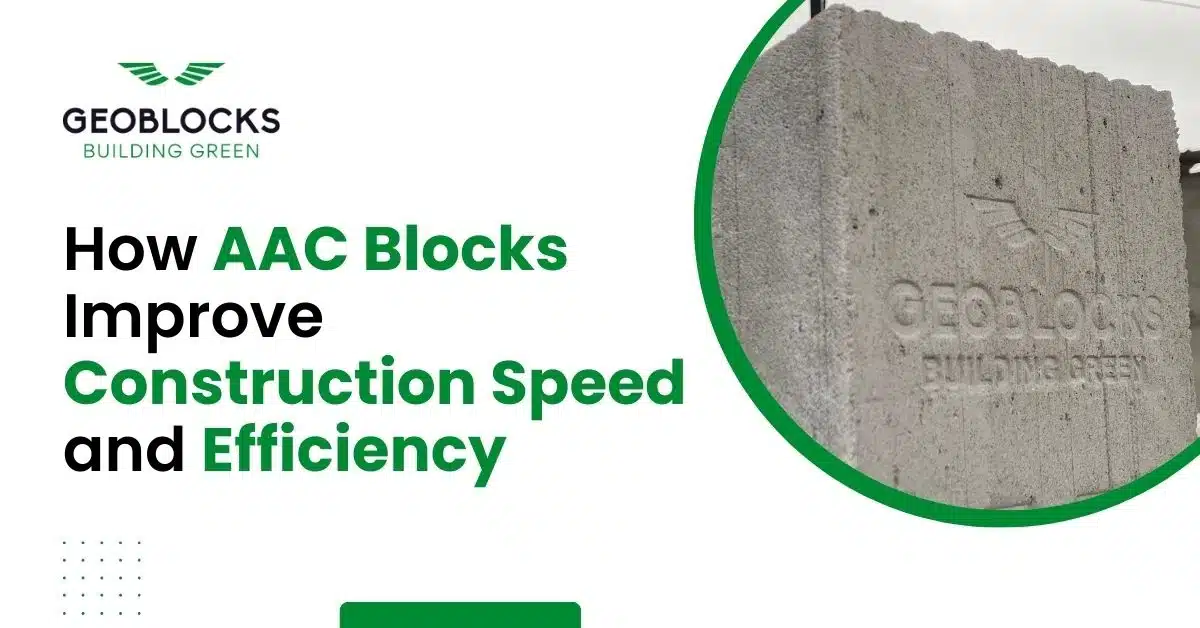In today’s world of smart construction and sustainable living, insulation plays a crucial role in…

Autoclaved Aerated Concrete (AAC) Blocks have revolutionized modern construction with their lightweight, durable, and eco-friendly properties. As a leading AAC Block Manufacturer in Vadodara, Gujarat, GEOBLOCKS is committed to providing high-quality AAC Blocks that enhance structural integrity and sustainability. However, designing with AAC Blocks requires careful consideration of various factors to maximize their benefits. This guide will help architects, engineers, and builders understand key design aspects for AAC Block structures.
Table of Content
Understanding AAC Blocks in Construction
AAC Blocks are precast, lightweight, and porous building materials made from cement, lime, sand, water, and an aerating agent. Their unique composition offers several advantages:
- Lightweight: Reduces dead load and structural costs.
- Thermal Insulation: Enhances energy efficiency in buildings.
- Fire Resistance: Provides excellent fire protection.
- Soundproofing: Improves acoustic performance.
- Eco-Friendly: Made from sustainable materials with minimal environmental impact.
Comparison with Traditional Bricks
AAC Blocks surpass Traditional Bricks with their lightweight structure, superior thermal insulation, and eco-friendly composition. They accelerate construction, lower costs, and improve energy efficiency. In terms of strength, durability, and sustainability, they are the following:
| Features | AAC Blocks | Traditional Bricks |
| Weight | Lightweight | Heavy |
| Thermal Insulation | High | Low |
| Soundproofing | Excellent | Moderate |
| Strength | Good | High |
| Cost Efficiency | Saves on Construction Time & Labor | Higher Labor Costs |
Build Smart with GEOBLOCKS! Ready to Enhance your Next Project with Durable and Eco-friendly AAC Blocks? Contact GEOBLOCKS today for Expert Solutions and Premium-quality AAC Blocks!
Structural Design Considerations
For long-lasting structures, AAC Blocks require proper reinforcement, optimal wall thickness, and a solid foundation. Ensuring correct placement and load distribution is key to maximizing structural integrity. Critical aspects to consider are the following:
1. Load-Bearing vs. Non-Load-Bearing Walls
AAC Blocks can be used for both load-bearing and non-load-bearing walls. For load-bearing walls, proper reinforcement and correct thickness selection are crucial.
2. Foundation Requirements
AAC structures require a strong foundation to handle their lightweight properties. A reinforced concrete foundation with damp-proofing measures is recommended.
3. Wall Thickness and Reinforcement
- Non-load Bearing Walls: 100-150mm Thickness.
- Load-bearing Walls: 200mm+ Thickness with Reinforcements.
- Use Steel Reinforcements in high-rise buildings for added strength.
Thermal and Sound Insulation Considerations
AAC Blocks naturally provide High Thermal Insulation, reducing HVAC costs in buildings. To enhance insulation:
- Use double-layer AAC Walls for extreme climates.
- Apply plaster or coatings to improve insulation.
- AAC walls can reduce outside noise by up to 40 dB, making them ideal for schools, hospitals, and residential areas.
Moisture and Water Resistance in AAC Structures
AAC Blocks have a porous structure, making them susceptible to water absorption. To prevent moisture-related issues:
- Use waterproof coatings or silicone-based sealants.
- Ensure proper drainage and plastering techniques.
Avoid prolonged exposure to water during construction.
Switch to Smarter Construction! Experience the benefits of lightweight, energy-efficient AAC Blocks. Contact GEOBLOCKS — your Trusted AAC Block Manufacturer in Gujarat.
Seismic and Fire Resistance Considerations
AAC Blocks provide superior seismic resistance by absorbing energy efficiently, reducing earthquake impact. Their fire resistance of up to 6 hours ensures enhanced safety in buildings. Key advantages of AAC Blocks are the following:
1. Seismic Performance
In earthquake-prone areas, AAC Blocks provide superior seismic resistance due to their lightweight and high energy absorption capacity. Design recommendations:
- Use reinforced AAC walls with lintel and tie beams.
- Add vertical and horizontal reinforcements at critical points.
2. Fire Resistance
AAC Blocks can withstand fire for up to 6 hours, making them ideal for fire-sensitive structures like hospitals and warehouses.
- Apply fire-resistant coatings for added protection.
- Use proper jointing mortar to avoid weak points.
Best Practices for Construction with AAC Blocks
- Use PU Adhesive instead of traditional cement mortar.
- Ensure proper curing to maintain strength and prevent cracks.
- Apply external plastering to protect against environmental damage.
- Follow recommended masonry techniques to improve load distribution.
Cost and Sustainability Benefits
AAC Blocks reduce construction costs, labor expenses, and maintenance efforts, making them a cost-effective choice. Their low carbon footprint, energy efficiency, and long-term durability contribute to sustainable construction. The major benefits are the following:
1. Cost-Effectiveness
- Faster Construction time reduces labor and material costs.
- Lower maintenance expenses due to high durability.
2. Eco-Friendly Construction
- Reduced CO2 emissions compared to conventional bricks.
- Less water consumption during production and construction.
Need Technical Guidance? Our Experts are here to help you design right with AAC Blocks. Schedule a Consultation with GEOBLOCKS Today!
Frequently Asked Questions
Are AAC Blocks suitable for high-rise buildings?
Yes, AAC Blocks are widely used in high-rise structures due to their lightweight and strength. However, reinforcement is necessary for added stability.
How do AAC Blocks perform in extreme weather conditions?
AAC Blocks provide excellent thermal insulation, making them suitable for both hot and cold climates.
Do AAC Block structures require special adhesives or mortar?
Yes, a PU Adhesive is recommended for better bonding and reduced material wastage.
Can AAC Blocks be used for both interior and exterior walls?
Yes, AAC Blocks are versatile and can be used for both applications with appropriate finishing.
How do AAC Blocks compare to red bricks in terms of durability?
While red bricks are stronger, AAC Blocks offer better insulation, fire resistance, and sustainability.
How to ensure proper curing and maintenance of AAC Block walls?
Minimal curing is required. Applying plaster and waterproof coatings enhances durability.
Conclusion
AAC Blocks are a game-changer in the construction industry, offering lightweight, energy-efficient, and sustainable solutions. However, proper design considerations such as structural reinforcements, moisture control, and seismic resistance are essential for maximizing their benefits.
GEOBLOCKS manufactures premium AAC Blocks that ensure durability, safety, and cost-effectiveness for all types of buildings. Choose GEOBLOCKS for your next project and build with strength, efficiency, and sustainability. Contact GEOBLOCKS today, for high quality AAC Blocks for your next Project!




